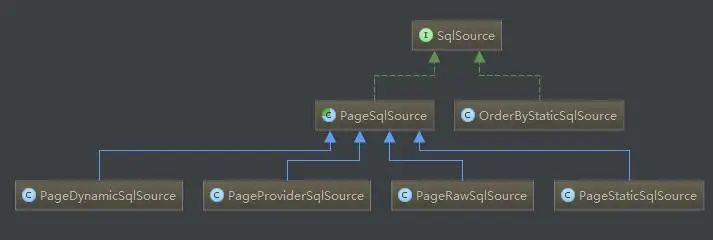PageHelper是一款好用的开源免费的Mybatis第三方物理分页插件,其实我并不想加上好用两个字,但是为了表扬插件作者开源免费的崇高精神,我毫不犹豫的加上了好用一词作为赞美。
原本以为分页插件,应该是很简单的,然而PageHelper比我想象的要复杂许多,它做的很强大,也很彻底,强大到使用者可能并不需要这么多功能,彻底到一参可以两用。但是,我认为,作为分页插件,完成物理分页任务是根本,其它的很多智能并不是必要的,保持它够傻够憨,专业术语叫stupid,简单就是美。
我们将简单介绍PageHelper的基本使用和配置参数的含义,重点分析PageHelper作为Mybatis分页插件的实现原理。
1. PageHelper的maven依赖及插件配置
<dependency> <groupId>com.github.pagehelpergroupId> <artifactId>pagehelperartifactId> <version>4.1.6version>dependency>PageHelper除了本身的jar包外,它还依赖了一个叫jsqlparser的jar包,使用时,我们不需要单独指定jsqlparser的maven依赖,maven的间接依赖会帮我们引入。
<plugin interceptor="com.github.pagehelper.PageHelper"> <property name="dialect" value="mysql" /> <property name="offsetAsPageNum" value="false" /> <property name="rowBoundsWithCount" value="true" /> <property name="reasonable" value="true" /> plugin>上面是PageHelper官方给的配置和注释,虽然写的很多,不过确实描述的很明白。
dialect:标识是哪一种数据库,设计上必须。
offsetAsPageNum:将RowBounds第一个参数offset当成pageNum页码使用,这就是上面说的一参两用,个人觉得完全没必要,offset = pageSize * pageNum就搞定了,何必混用参数呢?
rowBoundsWithCount:设置为true时,使用RowBounds分页会进行count查询,个人觉得完全没必要,实际开发中,每一个列表分页查询,都配备一个count数量查询即可。
reasonable:value=true时,pageNum小于1会查询第一页,如果pageNum大于pageSize会查询最后一页 ,个人认为,参数校验在进入Mybatis业务体系之前,就应该完成了,不可能到达Mybatis业务体系内参数还带有非法的值。
这么一来,我们只需要记住 dialect = mysql 一个参数即可,其实,还有下面几个相关参数可以配置。
autoDialect:true or false,是否自动检测dialect。
autoRuntimeDialect:true or false,多数据源时,是否自动检测dialect。
closeConn:true or false,检测完dialect后,是否关闭Connection连接。
上面这3个智能参数,不到万不得已,我们不应该在系统中使用,我们只需要一个dialect = mysql 或者 dialect = oracle就够了,如果系统中需要使用,还是得问问自己,是否真的非用不可。
2. PageHelper源码分析
@Intercepts(@Signature(type = Executor.class, method = "query", args = {MappedStatement.class, Object.class, RowBounds.class, ResultHandler.class}))public class PageHelper implements Interceptor { //sql工具类 private SqlUtil sqlUtil; //属性参数信息 private Properties properties; //配置对象方式 private SqlUtilConfig sqlUtilConfig; //自动获取dialect,如果没有setProperties或setSqlUtilConfig,也可以正常进行 private boolean autoDialect = true; //运行时自动获取dialect private boolean autoRuntimeDialect; //多数据源时,获取jdbcurl后是否关闭数据源 private boolean closeConn = true; //缓存 private Map urlSqlUtilMap = new ConcurrentHashMap(); private ReentrantLock lock = new ReentrantLock();// ...}上面是官方源码以及源码所带的注释,我们再补充一下。
SqlUtil:数据库类型专用sql工具类,一个数据库url对应一个SqlUtil实例,SqlUtil内有一个Parser对象,如果是mysql,它是MysqlParser,如果是oracle,它是OracleParser,这个Parser对象是SqlUtil不同实例的主要存在价值。执行count查询、设置Parser对象、执行分页查询、保存Page分页对象等功能,均由SqlUtil来完成。
SqlUtilConfig:Spring Boot中使用,忽略。
autoRuntimeDialect:多个数据源切换时,比如mysql和oracle数据源同时存在,就不能简单指定dialect,这个时候就需要运行时自动检测当前的dialect。
Map urlSqlUtilMap:它就用来缓存autoRuntimeDialect自动检测结果的,key是数据库的url,value是SqlUtil。由于这种自动检测只需要执行1次,所以做了缓存。
ReentrantLock lock:这个lock对象是比较有意思的现象,urlSqlUtilMap明明是一个同步ConcurrentHashMap,又搞了一个lock出来同步ConcurrentHashMap做什么呢?是否是画蛇添足?在《Java并发编程实战》一书中有详细论述,简单的说,ConcurrentHashMap可以保证put或者remove方法一定是线程安全的,但它不能保证put、get、remove的组合操作是线程安全的,为了保证组合操作也是线程安全的,所以使用了lock。
com.github.pagehelper.PageHelper.java源码。
// Mybatis拦截器方法 public Object intercept(Invocation invocation) throws Throwable { if (autoRuntimeDialect) { // 多数据源 SqlUtil sqlUtil = getSqlUtil(invocation); return sqlUtil.processPage(invocation); } else { // 单数据源 if (autoDialect) { initSqlUtil(invocation); } // 指定了dialect return sqlUtil.processPage(invocation); } } public synchronized void initSqlUtil(Invocation invocation) { if (this.sqlUtil == null) { this.sqlUtil = getSqlUtil(invocation); if (!autoRuntimeDialect) { properties = null; sqlUtilConfig = null; } autoDialect = false; } } public void setProperties(Properties p) { checkVersion(); //多数据源时,获取jdbcurl后是否关闭数据源 String closeConn = p.getProperty("closeConn"); //解决#97 if(StringUtil.isNotEmpty(closeConn)){ this.closeConn = Boolean.parseBoolean(closeConn); } //初始化SqlUtil的PARAMS SqlUtil.setParams(p.getProperty("params")); //数据库方言 String dialect = p.getProperty("dialect"); String runtimeDialect = p.getProperty("autoRuntimeDialect"); if (StringUtil.isNotEmpty(runtimeDialect) && runtimeDialect.equalsIgnoreCase("TRUE")) { this.autoRuntimeDialect = true; this.autoDialect = false; this.properties = p; } else if (StringUtil.isEmpty(dialect)) { autoDialect = true; this.properties = p; } else { autoDialect = false; sqlUtil = new SqlUtil(dialect); sqlUtil.setProperties(p); } } public SqlUtil getSqlUtil(Invocation invocation) { MappedStatement ms = (MappedStatement) invocation.getArgs()[0]; //改为对dataSource做缓存 DataSource dataSource = ms.getConfiguration().getEnvironment().getDataSource(); String url = getUrl(dataSource); if (urlSqlUtilMap.containsKey(url)) { return urlSqlUtilMap.get(url); } try { lock.lock(); if (urlSqlUtilMap.containsKey(url)) { return urlSqlUtilMap.get(url); } if (StringUtil.isEmpty(url)) { throw new RuntimeException("无法自动获取jdbcUrl,请在分页插件中配置dialect参数!"); } String dialect = Dialect.fromJdbcUrl(url); if (dialect == null) { throw new RuntimeException("无法自动获取数据库类型,请通过dialect参数指定!"); } SqlUtil sqlUtil = new SqlUtil(dialect); if (this.properties != null) { sqlUtil.setProperties(properties); } else if (this.sqlUtilConfig != null) { sqlUtil.setSqlUtilConfig(this.sqlUtilConfig); } urlSqlUtilMap.put(url, sqlUtil); return sqlUtil; } finally { lock.unlock(); } }autoRuntimeDialect:多数据源,会创建多个SqlUtil。
autoDialect:单数据源,只会创建1个SqlUtil。单数据源时,也可以当做多数据源来使用。
指定了dialect:只会创建1个SqlUtil。
3. PageSqlSource
public abstract class PageSqlSource implements SqlSource { /** * 获取正常的BoundSql * * @param parameterObject * @return */ protected abstract BoundSql getDefaultBoundSql(Object parameterObject); /** * 获取Count查询的BoundSql * * @param parameterObject * @return */ protected abstract BoundSql getCountBoundSql(Object parameterObject); /** * 获取分页查询的BoundSql * * @param parameterObject * @return */ protected abstract BoundSql getPageBoundSql(Object parameterObject); /** * 获取BoundSql * * @param parameterObject * @return */ @Override public BoundSql getBoundSql(Object parameterObject) { Boolean count = getCount(); if (count == null) { return getDefaultBoundSql(parameterObject); } else if (count) { return getCountBoundSql(parameterObject); } else { return getPageBoundSql(parameterObject); } }}getDefaultBoundSql:获取原始的未经改造的BoundSql。
getCountBoundSql:不需要写count查询,插件根据分页查询sql,智能的为你生成的count查询BoundSql。
getPageBoundSql:获取分页查询的BoundSql。
举例:
DefaultBoundSql:select stud_id as studId , name, email, dob, phone from students
CountBoundSql:select count(0) from students --由PageHelper智能完成
PageBoundSql:select stud_id as studId , name, email, dob, phone from students limit ?, ?

(Made In Intellij Idea IDE)
public class PageStaticSqlSource extends PageSqlSource { private String sql; private List parameterMappings; private Configuration configuration; private SqlSource original; @Override protected BoundSql getDefaultBoundSql(Object parameterObject) { String tempSql = sql; String orderBy = PageHelper.getOrderBy(); if (orderBy != null) { tempSql = OrderByParser.converToOrderBySql(sql, orderBy); } return new BoundSql(configuration, tempSql, parameterMappings, parameterObject); } @Override protected BoundSql getCountBoundSql(Object parameterObject) { // localParser指的就是MysqlParser或者OracleParser // localParser.get().getCountSql(sql),可以根据原始的sql,生成一个count查询的sql return new BoundSql(configuration, localParser.get().getCountSql(sql), parameterMappings, parameterObject); } @Override protected BoundSql getPageBoundSql(Object parameterObject) { String tempSql = sql; String orderBy = PageHelper.getOrderBy(); if (orderBy != null) { tempSql = OrderByParser.converToOrderBySql(sql, orderBy); } // getPageSql可以根据原始的sql,生成一个带有分页参数信息的sql,比如 limit ?, ? tempSql = localParser.get().getPageSql(tempSql); // 由于sql增加了分页参数的?号占位符,getPageParameterMapping()就是在原有List基础上,增加两个分页参数对应的ParameterMapping对象,为分页参数赋值使用 return new BoundSql(configuration, tempSql, localParser.get().getPageParameterMapping(configuration, original.getBoundSql(parameterObject)), parameterObject); }}假设List原来的size=2,添加分页参数后,其size=4,具体增加多少个,看分页参数的?号数量。
其他PageSqlSource,原理和PageStaticSqlSource一模一样。
解析sql,并增加分页参数占位符,或者生成count查询的sql,都依靠Parser来完成。
4. com.github.pagehelper.parser.Parser

(Made In Intellij Idea IDE)
public class MysqlParser extends AbstractParser { @Override public String getPageSql(String sql) { StringBuilder sqlBuilder = new StringBuilder(sql.length() + 14); sqlBuilder.append(sql); sqlBuilder.append(" limit ?,?"); return sqlBuilder.toString(); } @Override public Map setPageParameter(MappedStatement ms, Object parameterObject, BoundSql boundSql, Page> page) { Map paramMap = super.setPageParameter(ms, parameterObject, boundSql, page); paramMap.put(PAGEPARAMETER_FIRST, page.getStartRow()); paramMap.put(PAGEPARAMETER_SECOND, page.getPageSize()); return paramMap; }}我们可以清楚的看到,MysqlParser是如何添加分页占位符和分页参数的。
public abstract class AbstractParser implements Parser, Constant { public String getCountSql(final String sql) { return sqlParser.getSmartCountSql(sql); }}生成count sql,则是前文提到的jsqlparser工具包来完成的,是另外一个开源的sql解析工具包。
5. SqlUtil.doProcessPage()分页查询
// PageSqlSource装饰原SqlSource public void processMappedStatement(MappedStatement ms) throws Throwable { SqlSource sqlSource = ms.getSqlSource(); MetaObject msObject = SystemMetaObject.forObject(ms); SqlSource pageSqlSource; if (sqlSource instanceof StaticSqlSource) { pageSqlSource = new PageStaticSqlSource((StaticSqlSource) sqlSource); } else if (sqlSource instanceof RawSqlSource) { pageSqlSource = new PageRawSqlSource((RawSqlSource) sqlSource); } else if (sqlSource instanceof ProviderSqlSource) { pageSqlSource = new PageProviderSqlSource((ProviderSqlSource) sqlSource); } else if (sqlSource instanceof DynamicSqlSource) { pageSqlSource = new PageDynamicSqlSource((DynamicSqlSource) sqlSource); } else { throw new RuntimeException("无法处理该类型[" + sqlSource.getClass() + "]的SqlSource"); } msObject.setValue("sqlSource", pageSqlSource); //由于count查询需要修改返回值,因此这里要创建一个Count查询的MS msCountMap.put(ms.getId(), MSUtils.newCountMappedStatement(ms)); }// 执行分页查询private Page doProcessPage(Invocation invocation, Page page, Object[] args) throws Throwable { //保存RowBounds状态 RowBounds rowBounds = (RowBounds) args[2]; //获取原始的ms MappedStatement ms = (MappedStatement) args[0]; //判断并处理为PageSqlSource if (!isPageSqlSource(ms)) { processMappedStatement(ms); } //设置当前的parser,后面每次使用前都会set,ThreadLocal的值不会产生不良影响 ((PageSqlSource)ms.getSqlSource()).setParser(parser); try { //忽略RowBounds-否则会进行Mybatis自带的内存分页 args[2] = RowBounds.DEFAULT; //如果只进行排序 或 pageSizeZero的判断 if (isQueryOnly(page)) { return doQueryOnly(page, invocation); } //简单的通过total的值来判断是否进行count查询 if (page.isCount()) { page.setCountSignal(Boolean.TRUE); //替换MS args[0] = msCountMap.get(ms.getId()); //查询总数 Object result = invocation.proceed(); //还原ms args[0] = ms; //设置总数 page.setTotal((Integer) ((List) result).get(0)); if (page.getTotal() == 0) { return page; } } else { page.setTotal(-1l); } //pageSize>0的时候执行分页查询,pageSize<=0的时候不执行相当于可能只返回了一个count if (page.getPageSize() > 0 && ((rowBounds == RowBounds.DEFAULT && page.getPageNum() > 0) || rowBounds != RowBounds.DEFAULT)) { //将参数中的MappedStatement替换为新的qs page.setCountSignal(null); BoundSql boundSql = ms.getBoundSql(args[1]); args[1] = parser.setPageParameter(ms, args[1], boundSql, page); page.setCountSignal(Boolean.FALSE); //执行分页查询 Object result = invocation.proceed(); //得到处理结果 page.addAll((List) result); } } finally { ((PageSqlSource)ms.getSqlSource()).removeParser(); } //返回结果 return page; }源码中注意关键的四点即可:
1、msCountMap.put(ms.getId(), MSUtils.newCountMappedStatement(ms)),创建count查询的MappedStatement对象,并缓存于msCountMap。
2、如果count=true,则执行count查询,结果total值保存于page对象中,继续执行分页查询。
3、执行分页查询,将查询结果保存于page对象中,page是一个ArrayList对象。
4、
args[2] = RowBounds.DEFAULT,改变Mybatis原有分页行为;
args[1] = parser.setPageParameter(ms, args[1], boundSql, page),改变原有参数列表(增加分页参数)。
6. PageHelper的两种使用方式
第一种、直接通过RowBounds参数完成分页查询 。
List list = studentMapper.find(new RowBounds(0, 10));Page page = ((Page) list;第二种、PageHelper.startPage()静态方法
//获取第1页,10条内容,默认查询总数count PageHelper.startPage(1, 10);//紧跟着的第一个select方法会被分页 List list = studentMapper.find(); Page page = ((Page) list;注:返回结果list,已经是Page对象,Page对象是一个ArrayList。
原理:使用ThreadLocal来传递和保存Page对象,每次查询,都需要单独设置PageHelper.startPage()方法。
public class SqlUtil implements Constant { private static final ThreadLocal LOCAL_PAGE = new ThreadLocal();}本文中经常提到的count查询,其实是PageHelper帮助我们生成的一个MappedStatement内存对象,它可以免去我们在XXXMapper.xml内单独声明一个sql count查询,我们只需要写一个sql分页业务查询即可。
PageHelper使用建议(性能最好):
明确指定dialect。
明确编写sql分页业务和与它对应的count查询,别图省事。
祖大俊
my.oschina.net/zudajun/blog/745232
收藏了近800G古籍资料,发送【古籍】获取下载地址。
更多资料请戳【搜索】菜单,里面可自行搜索下载。

最后
以上就是碧蓝楼房最近收集整理的关于pagehelper的分页时最后一页数量少于pagesize时报_牛逼哄哄的PageHelper分页插件到底是怎么实现的?网友:给我10分钟,给你写一个...的全部内容,更多相关pagehelper内容请搜索靠谱客的其他文章。








发表评论 取消回复